Saturday Walking Street Chiang Mai: The Ultimate Guide to Wua Lai Road & the Silver Temple
Our complete guide to the Saturday Walking Street Chiang Mai. Discover the best of Wua Lai Road, from local crafts to amazing food & the stunning Silver Temple.
11/21/20259 min read
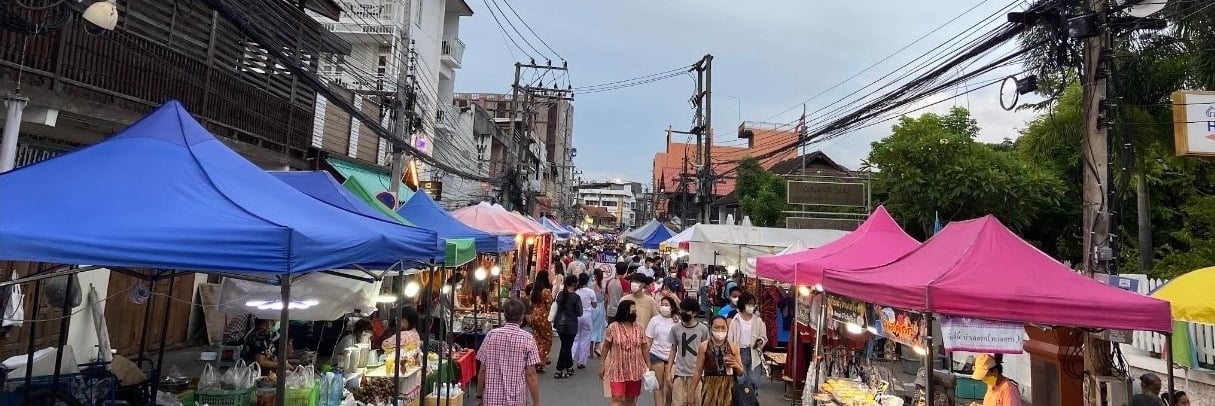

More Than a Market: An Insider's Guide to Wua Lai Road's Saturday Walking Street & the Silver Temple
When you ask anyone about markets in Chiang Mai, you’ll instantly hear about the famous Sunday Walking Street. It’s legendary, vast, and an absolute must-do. But what if I told you there’s another market, one that’s woven just as deeply into the city's cultural fabric, yet offers a completely different, perhaps even more intimate, experience?
Welcome to Wua Lai Road, home of the Saturday Walking Street.
This isn’t just an "alternative" to the Sunday market; it’s a destination in its own right, anchored by one of the most astonishing temples in all of Thailand: Wat Sri Suphan, the Silver Temple.
The Saturday Walking Street is a vibrant, pulsating artery of creativity. It’s narrower than its Sunday counterpart, which creates a cozy, bustling atmosphere. It’s a place where the air is thick with the competing aromas of grilling pork and sweet coconut pancakes, and the sound is a symphony of traditional Lanna music, laughing shoppers, and the rhythmic tap-tap-tap of silversmiths' hammers.
But to truly appreciate Wua Lai, you have to understand its story. This isn't just a random street chosen to host a market. This is Chiang Mai’s historic silversmithing quarter. The market you walk through today is a living celebration of an artistic heritage that is centuries old.
In this guide, we’re going to go beyond just "what to buy." We’ll dive into the soul of Wua Lai, explore the jaw-dropping beauty of its Silver Temple, map out the best food to eat, and give you the local tips you need to experience it all like a true insider.
Part 1: The Soul of the Street – The Silversmith's Heritage
To understand Wua Lai, you must first understand silver.
Long before it was a "walking street," Wua Lai Road was the heart of Chiang Mai's Lanna silver-making community. The heritage dates back over 200 years to when King Kawila, after retaking Chiang Mai from the Burmese, brought in artisans from various regions to rebuild the city. The silversmiths, many from Burmese Shan states, settled in this very neighborhood.
For generations, the families here have passed down the meticulous, painstaking art of repoussé—the technique of hammering and shaping malleable metal from the reverse side to create intricate, raised designs.
As you walk down the street before the market even starts, you’ll see the evidence. Tucked between guesthouses and cafes are the family-run workshops and silver shops that are the street's permanent residents. These are the true masters. You can (and should!) visit these shops during the day. Many have open-air workshops where you can watch artisans, both old and young, transforming flat sheets of metal into breathtaking bowls, jewelry, and ornate decorative panels.
This context changes everything. The Saturday Walking Street isn't just a collection of stalls; it’s a living showroom. The local families use this night to showcase their craft directly to you, bypassing the middleman. The silver jewelry you buy here isn't just a souvenir; it's a piece of Wua Lai's living history.
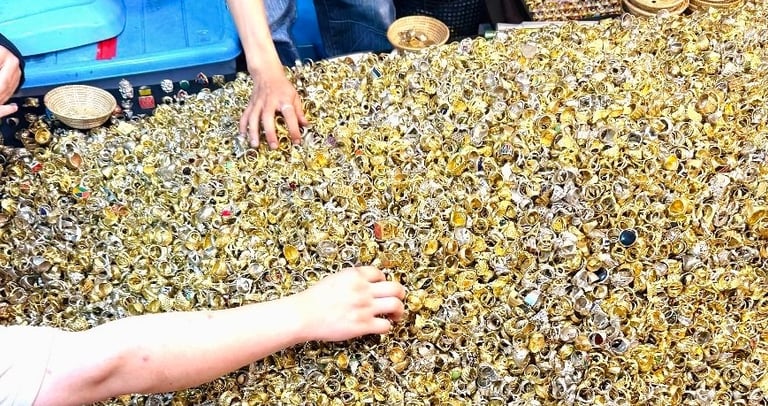

Part 2: The Crown Jewel – Wat Sri Suphan (The Silver Temple)
Anchoring the street, about halfway down, is the neighborhood's spiritual and artistic masterpiece: Wat Sri Suphan.
You might think you’ve seen enough temples in Chiang Mai, but I promise you, you have never seen anything like this.
From the outside, the entire ubosot (ordination hall) and the surrounding structures are covered in shimmering, intricately hammered metal panels. By day, it’s a dazzling, almost blinding spectacle as it reflects the Lanna sun. By night, when the market is in full swing, it’s illuminated with dramatic, colorful lights that change hue, making the silver glow against the dark sky.
Why Silver? The temple itself is ancient, founded around 1500. But the silver-clad ubosot you see today is a more recent (and ongoing) project. It was conceived by the temple's abbot as a way to honor the neighborhood's unique heritage. It is a living testament to the silversmiths' craft—a community project built by the very artisans who live and work on Wua Lai Road.
Look closely. The details are mind-blowing. You will see panels depicting stories from the Buddha's life (the Jataka tales), scenes from Lanna history, and even modern touches like references to global events, all rendered in hammered silver, zinc, and alloy.
An Important Cultural Note for Female Visitors: You must be aware of one crucial cultural custom. There is a sign at the entrance of the main silver ubosot (the ordination hall) stating that women are not permitted to enter.
Please, do not be offended. This is not a judgment or a sign of disrespect. This is due to a very old, traditional Lanna belief that a temple's ubosot—where monks are ordained and sacred relics are often buried beneath—holds a special energy. It is believed that a woman's presence could (unintentionally) disrupt this sacred energy or "compete" with the power of the relics.
It is a deeply-rooted custom that visitors are politely asked to respect.
What Women Can Do (Which is Everything Else!):
The exterior is the main event! 99% of the beauty and artistry is on the outside of the building, which you can walk around and photograph up close.
The rest of the temple grounds are completely open.
Visit the Silver Workshop: Behind the main hall, there is a workshop where you can see artists—both men and women—at work. You can even sign up for a short workshop to try hammering your own silver souvenir.
Explore other halls: There are other, older halls on the grounds that are open to everyone.
Local's Tip: Visit Wat Sri Suphan twice. First, go during the day (or around 4:00 PM, just before the market) to appreciate the sheer, unbelievable detail in the bright sunlight. Then, come back after 7:00 PM to see it magically illuminated.
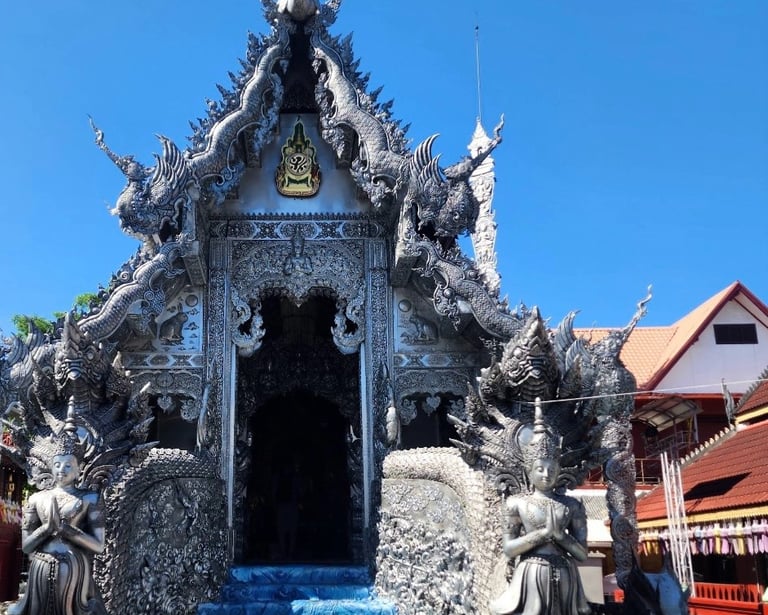

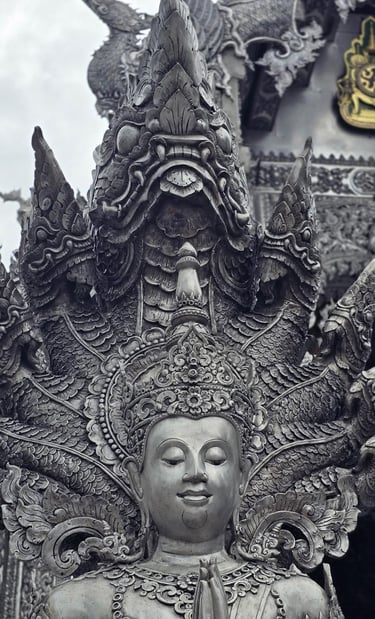

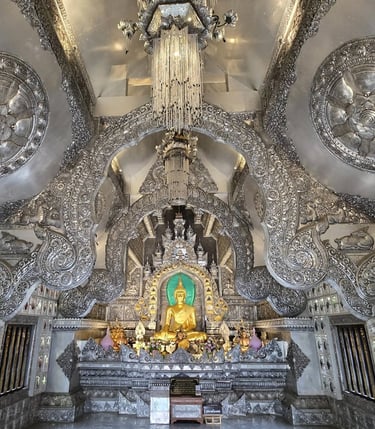

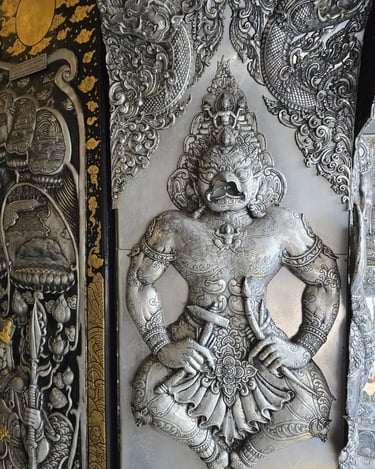

Part 3: A Guide to the Saturday Walking Street
The moment the clock strikes 4:00 PM, Wua Lai Road begins its transformation. The street is closed to traffic, and in a flurry of organized chaos, hundreds of vendors roll in their carts, unfurl their tents, and lay out their wares. By 5:00 PM, the market is on.
The Practical Details:
When: Every Saturday, from roughly 5:00 PM to 10:30 PM. (It’s best to go around 6:00 PM as all stalls are set up).
Where: Wua Lai Road. It starts at the Chiang Mai Gate, on the south side of the Old City moat, and runs for about 1 kilometer.
How to Get There:
On Foot: If you're in the Old City, it's an easy walk. Just head to the Chiang Mai Gate.
By Songthaew (Red Truck) or Tuk-Tuk: Tell the driver "Wua Lai" or "Saturday Walking Street." They will drop you at the entrance, as they can't drive down the street itself.
By Grab: Set your destination to "Chiang Mai Gate."
The Vibe: Saturday vs. Sunday So, what’s the difference between this and the Sunday Walking Street?
Size: Wua Lai is smaller and the street is narrower. This makes it feel more crowded and intimate.
Focus: The Sunday Market is enormous and has everything. Wua Lai feels more focused on craftsmanship, especially silver, textiles, and apparel.
Atmosphere: I find Wua Lai to be slightly more "local," with a buzzing, creative energy.
What to Buy: A Shopper's Paradise This is a fantastic place to buy high-quality, unique souvenirs.
Silver: Of course! You will find everything from delicate modern jewelry to massive, ornate bowls. Look for the "92.5" stamp (for sterling silver).
Handicrafts: This is one of the best spots for Lanna crafts. Look for hand-carved wooden boxes, intricate lacquerware, handmade paper lanterns, and beautiful ceramics.
Textiles: You’ll find a sea of "elephant pants," but look deeper. There are stalls selling gorgeous, hand-woven silks, indigo-dyed fabrics from Phrae, and unique apparel from local Chiang Mai designers.
Art: Dozens of local painters and illustrators sell their original works and prints.
A Note on Bargaining: Polite haggling is acceptable, especially if you are buying multiple items from one vendor. But remember, many of these stalls are run by the artists themselves. Don't be aggressive. A smile and a simple "Can you do a better price?" is the way to go.
Part 4: A Foodie's Tour of Wua Lai
You can't talk about a Thai market without talking about the food. And Wua Lai is a foodie's dream. The entire street is an open-air buffet.
The Strategy: The best food stalls are clustered at two main points:
At the Chiang Mai Gate: Before you even enter the market, there is a massive, permanent food market with dozens of stalls. This is a great place to start.
In Temple Courtyards: Several temples along Wua Lai, like Wat Muen Sarn, open their grounds to vendors. This is a fantastic pro-tip: duck into these courtyards to find amazing food and, most importantly, a place to sit down!
Must-Eat Dishes:
Sai Oua (Chiang Mai Sausage): You’ll smell it before you see it. A coil of pork sausage packed with herbs and spices, grilled over charcoal.
Moo Ping (Grilled Pork Skewers): Sweet, smoky, and addictive. Often eaten with a small bag of khao niao (sticky rice).
Gai Yang (Grilled Chicken): Perfectly marinated chicken, grilled to perfection.
Kanom Krok: Tiny, sweet and savory coconut-rice pancakes cooked in a special cast-iron pan.
Squid on a Stick: Grilled squid, brushed with a spicy, sweet-sour sauce.
Pad Thai & Khao Soi: You can find classic dishes cooked to order.
Desserts: Don't miss the coconut ice cream served in a coconut shell, mango sticky rice, or colorful Roti (sweet flatbread) fried with banana and egg.
Drinks: Grab a passionfruit smoothie or a cup of bright-blue butterfly pea tea to stay hydrated.
The Rule: If you see a long line of locals, get in it. It’s guaranteed to be good.
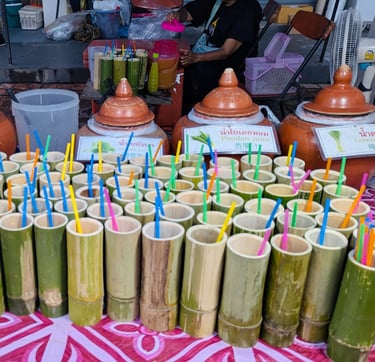

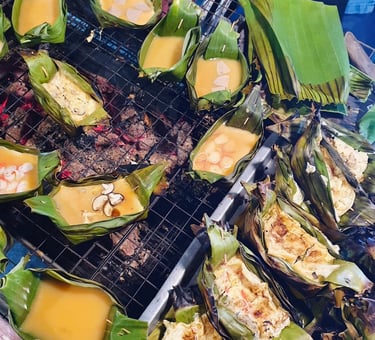

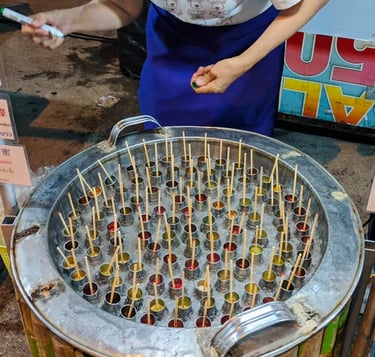


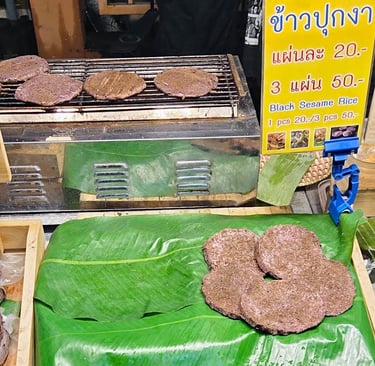
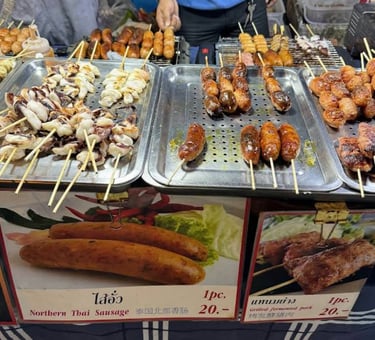



Your Perfect Saturday Night, Your Perfect Way to Recover
Wua Lai Road is a truly magical experience. It's a journey into the artistic heart of Chiang Mai. You can watch an artisan hammer a silver bowl, listen to a blind minstrel play a traditional Lanna pin (lute), buy a one-of-a-kind painting, and eat five different amazing snacks, all in the shadow of a glowing, 500-year-old temple.
But let's be realistic. After three hours of walking on hard pavement, weaving through crowds, and carrying bags heavy with crafts and silver, your body is going to be talking to you. Your feet will be aching. Your shoulders will be tight. Your lower back will be stiff.
This is all part of the glorious "market experience." But what if I told you the perfect cure was waiting for you right where you started?
The Saturday Walking Street begins at the Chiang Mai Gate. And as you exit the market, feeling tired but happy, you’ll find our C&R Thai Massage (Chiang Mai Gate branch) right there, a quiet sanctuary waiting to welcome you.
Imagine stepping out of the noisy, bustling street and into our calm, fragrant space. Sinking into a plush chair and letting a skilled therapist work away the soreness from your feet and calves with a dedicated Foot Massage. Or perhaps, opting for a full Traditional Thai Massage to stretch out your back and hips, undoing all the knots from your shopping adventure.
It is, quite literally, the perfect end to a perfect Chiang Mai Saturday. You've nourished your soul with art and culture; now it's time to restore your body.
We hope you love Wua Lai Road as much as we do. Enjoy the crafts, savor the food, and we’ll be right here waiting to help you relax afterward.
Branch 1: Sunday Walking Street
(10 AM - 10PM)
Address: 145/8 Rajdamnern Road T. Prasingh
A. Mueng Chiang Mai 50200
Branch 2: Chiang Mai Gate
(10 AM - 10PM)
Address: 18/5 Rat Chiang Saen Road T. Hai Ya
A. Mueng Chiang Mai 50100
Phone Number:
+66 (0) 96 696 2874
+66 (0) 94 601 6207
Email: services.crgroup@gmail.com
